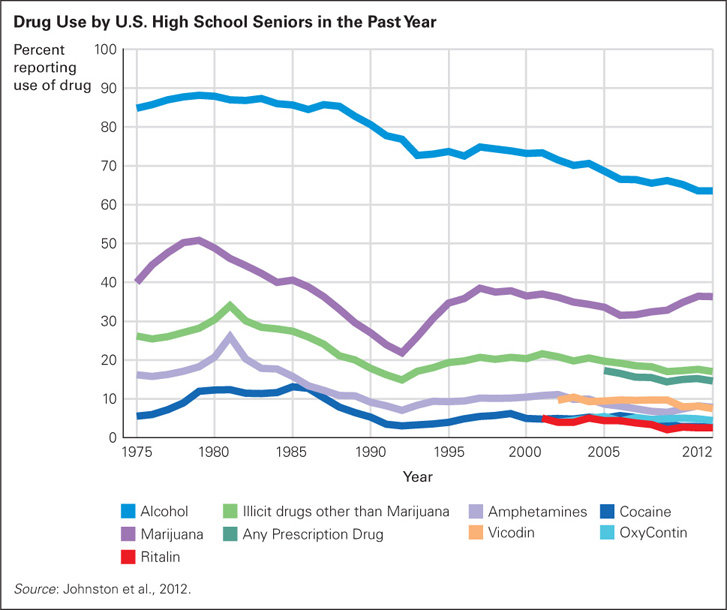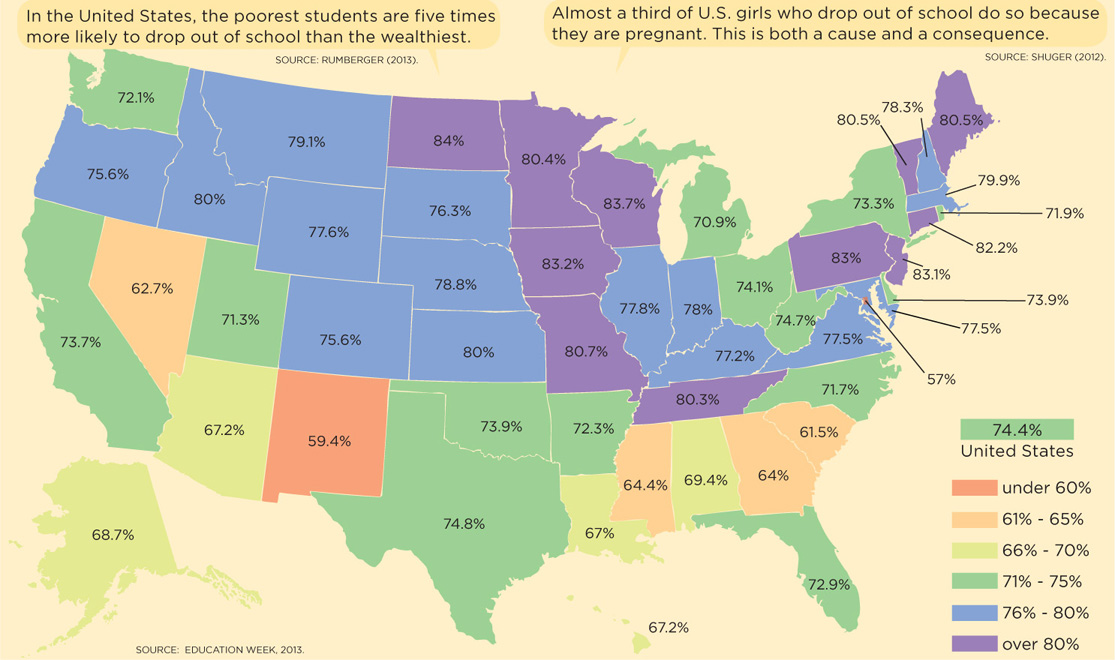 Drug Use and Abuse
Drug Use and Abuse
Hormonal surges, the brain’s reward centers, and cognitive immaturity make adolescents particularly attracted to the sensations produced by drugs. But their immature bodies and brains make drug use especially hazardous.
Variations in Drug Use
Most teenagers try psychoactive drugs, that is, drugs that activate the brain. To a developmentalist (but not to a police officer), cigarettes, alcohol, and many prescription medicines are as addictive and damaging as illegal drugs such as marijuana, cocaine, and heroin.
Age Trends
Both the prevalence and incidence of drug use increase from about ages 10 to 25 and then decrease, with use before age 18 being the best predictor of later abuse. Many studies find that use of alcohol and cigarettes before age 15 is an ominous sign: It correlates with depression, sexual abuse, bullying, and later addiction (Merikangas & McClaire, 2012; Mennis & Mason, 2012). Girls under age 15 who have boyfriends are particularly vulnerable to early substance use and later addiction (Poulin et al., 2011).
Use of only one drug category decreases with age—
Variations by Place, Generation, and Gender
Nations vary markedly in drug use. Consider the most common drugs: alcohol and tobacco. In most European nations, alcohol is part of every dinner, and children as well as adults partake. In much of the Middle East, alcohol is illegal, and teenagers almost never drink. The only alcohol available is concocted illegally, and is distasteful and dangerous—
Cigarettes are available everywhere, but national differences are dramatic. In many Asian nations, anyone anywhere may smoke cigarettes; in the United States, adolescents are forbidden to buy or smoke them, and smoking by anyone of any age is prohibited in many places. Nonetheless, 40 percent of U.S. high school seniors have smoked (Johnston et al., 2012). In Canada, cigarette advertising is outlawed, and cigarettes packs have graphic pictures of diseased lungs, rotting teeth, and so on; only 14 percent of Canadian 15-
Especially for Police Officers You see some 15-
Response for Police Officers: Avoid both extremes: Don’t let them think this situation is either harmless or serious. You might take them to the police station and call their parents. These adolescents are probably not life-

Variations within nations are also marked. In the United States, most high school seniors have tried alcohol (70 percent), and almost half have smoked cigarettes or marijuana—
Cohort differences are evident, even over a few years. Use of most drugs has decreased in the United States since 1976 (see Figure 16.6, p. 480), with the most notable decreases in marijuana and the most recent decreases in synthetic narcotics and prescription drugs (Johnson et al., 2012).

FIGURE 16.6
Rise and Fall By asking the same questions year after year, the Monitoring the Future study shows notable historical effects. It is encouraging that something in society, not in the adolescent, makes drug use increase and decrease and that the most recent data show a decline in use. However, as Chapter 1 emphasized, survey research cannot prove what causes change.Longitudinal data show that the availability of drugs does not have much impact on use: Most high school students say they could easily get alcohol, cigarettes, and marijuana if they wish (MMWR, June 8, 2012). However, perception of risks varies from cohort to cohort, and that has a large effect on use.

With some exceptions, adolescent boys use more drugs, and use them more often, than girls do, especially outside the United States (Mennis & Mason, 2012). For example, an international survey of 13-
These gender differences are reinforced by social constructions about proper male and female behavior. In Indonesia, for instance, 38 percent of the boys smoke cigarettes, but only 5 percent of the girls do. One Indonesian boy explained, “If I don’t smoke, I’m not a real man” (quoted in Ng et al., 2007).
In the United States, females smoke cigarettes less than males (for high school seniors the rates are 15 and 21 percent), but they drink alcohol at younger ages (Johnston et al., 2010). Body image is important for both sexes, leading to drug differences: Boys use steroids and girls use diet drugs. [Lifespan Link: The impact of body image on development was discussed in Chapter 14.]
Harm from Drugs
Many researchers find that drug use before maturity is particularly likely to harm body and brain growth. However, adolescents are especially likely to deny that they ever could become addicted to drugs. Few adolescents notice when they or their friends move past use (experimenting) to abuse (experiencing harm) and then to addiction (needing the drug to avoid feeling nervous, anxious, sick, or in pain).
Each drug is harmful in a particular way. An obvious negative effect of tobacco is that it impairs digestion and nutrition, slowing down growth. This is true for bidis, cigars, pipes, and chewing tobacco as well as for cigarettes. Since internal organs continue to mature after the height spurt, drug-
Especially for Parents Who Drink Socially You have heard that parents should allow their children to drink at home, to teach them to drink responsibly and not get drunk elsewhere. Is that wise?
Response for Parents Who Drink Socially: No. Alcohol is particularly harmful for young brains. It is best to drink only when your children are not around. Children who are encouraged to drink with their parents are more likely to drink when no adults are present. It is true that adolescents are rebellious, and they may drink even if you forbid it. But if you allow alcohol, they might rebel with other drugs.
Alcohol is the most frequently abused drug in North America. Heavy drinking impairs memory and self-
Marijuana seems harmless to many people (especially teenagers), partly because users seem more relaxed than inebriated. Yet adolescents who regularly smoke marijuana are more likely to drop out of school, become teenage parents, be depressed, and later be unemployed.
Marijuana affects memory, language proficiency, and motivation (Lane et al., 2005)—all of which are especially crucial during adolescence. An Australian study found that even occasional marijuana use (once a week) before age 20 affected development up to 10 years later (Degenhardt et al., 2010).
Some researchers wonder whether these are correlations, not causes. It is true that depressed and abused adolescents are more likely to use drugs, and that later these same people are likely to be more depressed and further abused. Maybe the stresses of adolescence lead to drug use, not vice versa.
However, longitudinal research suggests that drug use causes more problems than it solves, often preceding anxiety disorders, depression, and rebellion (Chassin et al., 2009; Meririnne et al., 2010). Longitudinal studies of twins (which allow control of genetics and family influences) find that, although many problems predate drug use, drugs themselves add to the problems (Lynskey et al., 2012; Korhonen et al., 2012).
Marijuana is often the drug of choice among wealthier adolescents, who then become less motivated to achieve in school and more likely to develop other problems (Ansary & Luthar, 2009). It seems as if, rather than lack of ambition leading to marijuana use, marijuana destroys ambition.
Preventing Drug Abuse: What Works?
Drug use is a progression, beginning with a social occasion and ending in a solitary place. The first use usually occurs with friends; occasional use seems to be a common expression of friendship or generational solidarity. An early sign of trouble is lower school achievement, but few notice that as early as they should (see Visualizing Development, p. 482, for school dropout rates).
However, the Monitoring the Future study found that in 2012:
- 24 percent of high school seniors report having had five drinks in a row in the past two weeks.
- 9 percent smoked cigarettes every day for the past month.
- 6.5 percent smoked marijuana every day.
[Johnston et al., 2012]
VISUALIZING DEVELOPMENT
How Many Adolescents Are in School?
Attendance in secondary school is a psychosocial topic as much as a cognitive one. Whether or not an adolescent is in school reflects every aspect of the social context, including national policies, family support, peer pressures, employment prospects, and other economic concerns. Rates of violence, delinquency, poverty, and births to girls younger than 17 increase as school attendance decreases.
PERCENTAGE OF YOUNG ADOLESCENTS (AGES 12–15) NOT IN SCHOOL

SELECTED SECONDARY SCHOOL GRADUATION RATES

U.S. HIGH SCHOOL GRADUATION RATE, CLASS OF 2010

These figures are ominous, suggesting that addiction is the next step. Another problem is synthetic marijuana (“spice”), which was not widely available until 2009 and was used by 11 percent of high school seniors in 2011 (Johnston et al., 2012). And although prescription drug use may seem harmless, since the source originally was a physician, many adolescents are already addicted to prescription drugs.
Remember that most adolescents think they are exceptions, sometimes feeling invincible, sometimes extremely fearful of social disapproval, but almost never worried that they themselves will become addicts. They rarely realize that every psychoactive drug excites the limbic system and interferes with the prefrontal cortex.
Because of these neurological reactions, drug users are more emotional (varying from ecstasy to terror, from paranoia to rage) than they would otherwise be, as well as less reflective—
generational forgetting The idea that each new generation forgets what the previous generation learned. As used here, the term refers to knowledge about the harm drugs can do.
With harmful drugs, as with many other aspects of life, each generation prefers to learn things for themselves. A common phenomenon is generational forgetting, the idea that each new generation forgets what the previous generation learned (Chassin et al., 2009; Johnston et al., 2012). Mistrust of the older generation, added to loyalty to one’s peers, leads not only to generational forgetting but also to a backlash. If a friend passes out from drug use, adolescents try to protect the friend from adult awareness rather than getting medical help. If adults forbid something, that may be a reason to try it.
Some antidrug curricula and advertisements using scare tactics (such as D.A.R.E. initiatives or the TV commercial that showed eggs in a hot frying pan as “This is your brain on drugs”) have no effect. Instead, they make drugs seem exciting. Antismoking announcements produced by cigarette companies (such as a clean-
This does not mean that trying to halt early drug use is hopeless. Massive ad campaigns by public health advocates in Florida and California cut adolescent smoking almost in half, in part because the publicity appealed to the young. One effective ad depicted young people dumping 1,200 body bags in front of the corporate headquarters of a tobacco company to highlight the number of smoking-

Both parental example and social changes make a difference. Throughout the United States, higher prices, targeted warnings, and better law enforcement have led to a marked decline in cigarette smoking among younger adolescents. In 2012, only 5 percent of eighth-
Looking broadly at the past three chapters and the past 40 years in the United States, we see that the universal biological processes do not lead to universal psychosocial problems. Sharply declining rates of teenage births and abortions (Chapter 14), increasing numbers graduating from high school (Chapter 15), and less use of legal and illegal drugs are apparent in many nations. Adolescence starts with puberty, that much is universal. But what happens next depends on parents, peers, culture, and society.
SUMMING UP
Most adolescents worldwide try drugs, usually cigarettes and alcohol. Drug use and abuse vary depending on age, culture, cohort, laws, and gender, with almost all adolescents in some nations using drugs that are never tried in other nations. Drug use early in adolescence is especially risky, since many drugs reduce learning and growth, harm the developing brain, and make later addiction more likely. Generational forgetting is one reason each cohort has distinctive drug-